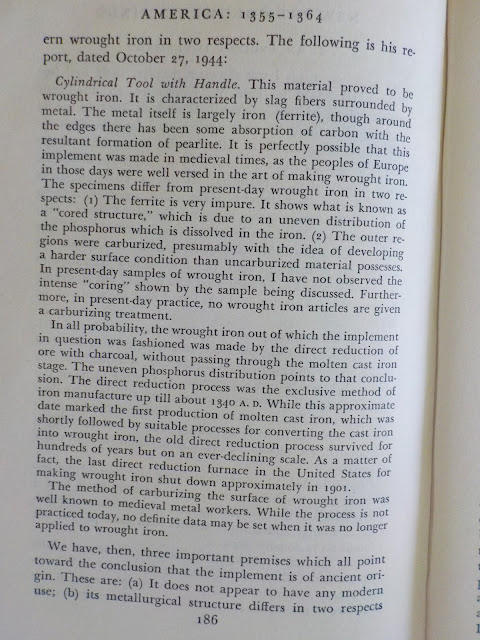Hjalmar R. Holand convinced himself and many of his followers that the many authentic medieval Scandinavian stoneholes to be found in this region of Minnesota were left-overs from the Paul Knutsen search party looking for "Lost Greenlanders." He extended his mistake to include some iron weapons and other iron objects he attributed to being left behind by this unsubstantiated search party.
Here in this WWII-era book, Holand shows and describes many of the stoneholes and iron objects found over the years in Minnesota. Unfortunately, he ascribed stoneholes as being for mooring boats, which is an untenable conclusion, based on the topography of the landscape. The watery landscape is currently about what it was like several hundred years ago, so obviously, the many stoneholes in Minnesota were made for other reasons--which I won't go into here. Suffice to say that Holand was wrong about what the purpose was for this old tool seen above. Certainly, it was not used as a "mooring hook."





Nor was this tool used for the purpose given in this signage I photographed at the Runestone Museum about ten years ago. Today, the Director of the museum graciously sent me an updated photo of the tool, as seen below, and I will share with her the contents of this blog posting once I have completed it. One can readily see that this is the same object Holand talked about so extensively in his book. So then, in my personal view, the item is currently still misidentified.
"The sharpened point on this would have been inserted into a wooden handle," the signage at the museum says. However, this is not correct. For its true purpose to be realized, one must consider that a portion of the tool has been broken off...that being the bottom section of the auger bit. One would also need to realize that a wooden handle was meant to go into the circular portion of the tool, so that the tool could be used for what it was intended to be: a woodworking tool, a wood borer, auger...a drill, if you will.
What is described here in the museum information, below, is actually a "scorpe," a single-handed, circular draw knife. But, what is missing on the tool in the museum to be a scorpe? The angle. The tool has no angle...the so-called cutting edge is not even close to being perpendicular to the handle. (That was one of the first clues I had, letting me know to do more research.)
Observe the tool below, second from the left. As you can see, if the bottom portion of the tool were broken off, we would have an exact replica of the woodworking tool at the Runestone Museum. But, again, unlike a scorpe, there is no angle to the tool. The tool at the Runestone Museum may appear to be sharp around the circular portions, but that is only because the tool-maker wanted the wooden handle to fit as seamlessly as possible into the metal circle.
This type of auger-drill was also used in boatmaking, which could explain why the Runestone Museum's woodworking tool was found near a lakeshore.
The above-seen book about Jamestown was published long enough ago that if the number of years until now were added onto their estimate of the age of their wood-auger, it could now be around 400 years old...which means that the Runestone Museum's artifact may also be at least 400 years old.
However, one should keep in mind that the tool from Jamestown may have been around in use for some number of years before it was lost...especially if it had been brought over from Europe.
So, the takeaway is that the Lake Latoka woodworking tool may have been broken and discarded by 17th century French fur traders, perhaps building a boat or an early trading post near Alexandria.
But again, though, it's possible that the tool could be older or newer than about 400 years, depending on how far back this type of woodworking tool had been in use without design change, and how far ahead into "modern times" it was made and used without design change.
For example, here pictured below is an auger for sale advertised as being from the 19th century, which causes to to wonder if the Runestone Museum's auger (found in 1938) may possibly even be from Minnesota's early immigrant pioneering days...perhaps from around the time of the Civil War.
Maybe past chemical analysis performed on the Runestone Museum's auger may end up some day helping to prove its age-range, one way or the other. Until that time, we can at least now know that the still-mysterious object is definitely not a mooring hook--nor a draw knife, either...it's actually a snapped-off, handle-less, woodworking auger piece.
A scorpe from the 14th century is shown above, far right and bottom, on this page from thomasguild.blogspot.com. Notice the near-perpendicular angle? So, the Runestone Museum's information is correct in describing what inshaves and scorpes are used for--except that their old woodworking tool isn't a scorpe.
Lastly, here is a modern scorpe draw knife.
















Comments
Post a Comment